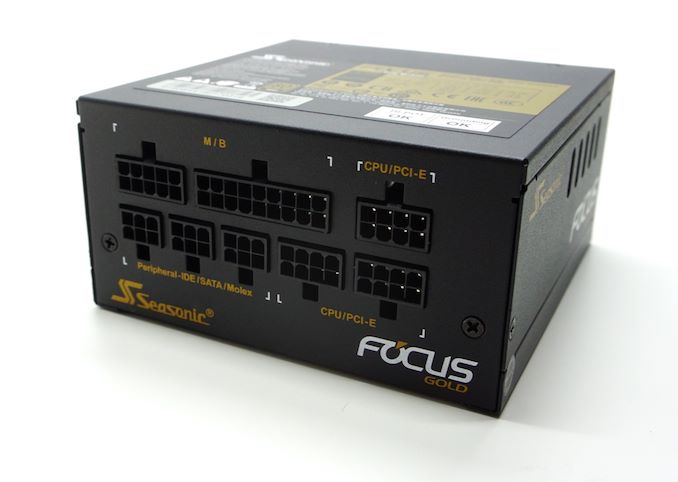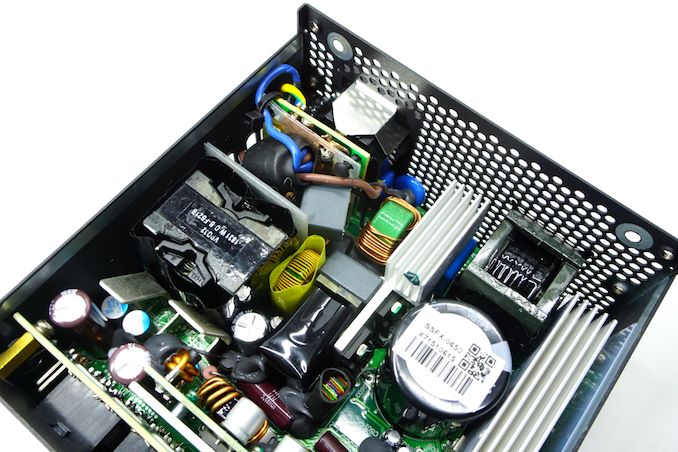The SeaSonic Focus Gold SGX-650 SFX Power Supply Review: Seasonic Starts off SFX With a Stunner
by E. Fylladitakis on March 7, 2019 8:30 AM EST- Posted in
- Cases/Cooling/PSUs
- Seasonic
- PSUs
- SFX
- Focus Gold SGX
Final Words
The new Focus Gold SGX series marks SeaSonic’s effort to enter the premium SFX PSU market with their own product. SeaSonic’s approach here is refreshingly modest, with the company opting not to build a halo product with a price tag that would instantly drive almost everyone away, but rather to design and develop a very reliable and high-performing PSU with a reasonable $129 price tag.
The high quality of the Focus Gold SGX-650 probably is its biggest selling point. It is an exceptionally well-designed and constructed PSU, with components coming from the best manufacturers and a fantastic assembly job. So it is not surprising that SeaSonic backs their power supply with a 10 year warranty.
Under normal operating conditions we recorded excellent performance figures on all fronts – electrical, thermal, and acoustic. SeaSonic is known for their emphasis on power quality and their new SFX unit is no exception, with exceptional power quality and power stability figures. The operating temperature of the Focus Gold SGX-650 is relatively low and the 120 mm fan is not to blame for that, as it barely is necessary when the unit operates in room temperature and under typical loads.
The Focus Gold SGX-650 also delivers very good performance while operating under high ambient temperatures, but there is a catch – it really doesn't want to be heavily loaded. After all, SeaSonic does de-rate the unit down to 80% capacity when the ambient temperature exceeds 40°C, and in our testing this seems like a prudent move. The overall performance of the power supply drops significantly when it's pushing over 550 Watts while operating under high temperatures, suggesting that these actually are overload conditions for the unit. In fact I'd probably go one step further and suggest that the PSU shouldn't be used with a load over 500 W if it really is going to be used under harsh ambient conditions.
Overall, high performance SFX PSUs are slowly but surely gaining ground on the PC market. And while the current selection of SFX products is rather limited, SeaSonic has certainly created a very interesting competitor with the Focus Gold SGX-650. Thanks to the high quality design of the power supply, it's currently one of the best-performing SFX PSUs available; and that's even if we take into account its disdain for hot environments.












38 Comments
View All Comments
Sivar - Thursday, March 7, 2019 - link
I thought I'd report a typo: "Although the selection of **hgih**-end SFX PSUs"Thank you for the article.
Ryan Smith - Thursday, March 7, 2019 - link
Thanks!SonicIce - Thursday, March 7, 2019 - link
There was a short period where their high end PSU's were manufactured in Taiwan with a 12 year warranty. Wonder why they went back to China?Hul8 - Thursday, March 7, 2019 - link
The Focus series is not high end, that's why.Alistair - Thursday, March 7, 2019 - link
It's a review without a comparison to the Corsair model? What kind of review is that...Alistair - Friday, March 8, 2019 - link
That came out more negative than I meant it to. But I mainly want to know what advantages the Seasonic model might have vs. the Corsair one.FXi - Thursday, March 7, 2019 - link
This might make a very nice and quiet PSU for the Alienware amplifierR3MF - Friday, March 8, 2019 - link
"Opting to go with a 1200mm anyhow, SeaSonic has lengthened the chassis slightly, so the Focus Gold SGX-650 measures 25 mm longer than a standard SFX PSU"The missing part that seems pretty crucial for a product review:
"We call this SFX-L", folks. It won't fit in a traditional SFX chassis, but that's fine because it's better. But as responsible reviewers, we thought you should know that."
Your welcome. ;)
PeachNCream - Friday, March 8, 2019 - link
It's a good point, but the manufacturer is pretty clear about it on sites where the PSU in question can be purchased. There are a number of SFF cases that will accept SFX-L power supplies too because its difficult to cram mid- to high-output circuitry into a standard SFX supply. I do agree that it ought to be more clearly noted in the article, but there are other places where a potential buyer will have a chance to discover the size before making a purchase.justareader - Friday, March 8, 2019 - link
The whole article is about SFX with no explanation. SFX is mention over and over and over. Does the author know? Does not matter this is a tech site, acronyms should always be stated complete at least once.